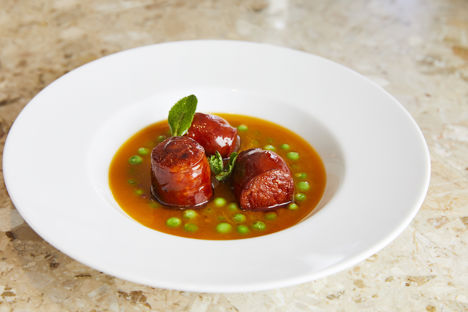
Spanish spice: choosing the right chorizo
As one of the most delicious things to come out of Spain, it’s no wonder chorizo is a hugely popular ingredient in the UK. But not all of these tasty red-hued sausages are the same – take a look at the different varieties and how they’re best used in cooking.
Spanish spice: choosing the right chorizo
As one of the most delicious things to come out of Spain, it’s no wonder chorizo is a hugely popular ingredient in the UK. But not all of these tasty red-hued sausages are the same – take a look at the different varieties and how they’re best used in cooking.
Spain is home to amazing wines, beautiful fresh produce, incredible pork and fantastic seafood. But if you ask most people to name the one Spanish ingredient they love above all, most would choose chorizo. This cured sausage has the ability to transform almost any dish, whether it’s the star of the recipe or is used as a supporting act to fish, vegetables or other meats. The rich flavour of pork is cut through with the sweet, smoky, heady scent of paprika (or pimentón) which doesn’t just taste great – it has the ability to lend its dark red colour to anything it touches.
As a general rule, Spanish chorizo must contain pork, paprika, garlic and salt – but there are hundreds of different varieties found across Spain which riff on the original recipe and come in all sorts of shapes, sizes and textures. Some can be eaten straight away while others need to be cooked; some are spicy and others sweet. And if you know the differences between them, you’re in a much better position to use the right type of chorizo in your cooking.
The one ingredient that makes the most difference to a chorizo’s flavour is the paprika used. It can be smoked, unsmoked, sweet or hot, and every region of Spain has its preferences. Chorizo producers will also sometimes add wine, peppercorns, herbs or even a little cumin to their sausages for a slightly different flavour profile.
Chorizo is made much like any other cured sausage. The pork meat is minced with plenty of lard or cubed pork fat, before being mixed with the right ratio of salt as well as paprika, garlic and any other spices or flavourings. The mixture is then left to marinate and ferment for a few days to allow the flavours to meld together and become subtly acidic, at which point it is stuffed into a natural casing. Most chorizo is then hung up to dry like any other charcuterie – although the amount of time differs depending on the variety. Take a look at the different styles of Spanish chorizo below and discover the best ways to cook with them.
Sarta
These are the most common chorizo in the UK, and probably the first encounter many of us have had with this fantastic Spanish ingredient. Shaped like a horseshoe and tied with a small length of string at the end, this variety of chorizo is completely cured and can be eaten straight out of the packet. Cut it into thin slices and enjoy with a few slices of Manchego cheese and a glass of sherry. Many people use it for cooking, too, because the sausage releases rich red oils when fried that can completely transform a dish.
Ristra
Fresh (or soft) chorizo isn’t as popular as the dried variety in the UK, but if you do happen to come across some make sure you snap it up. These sausages are only semi-cured, so they’re more like the British sausages you see at the butchers (albeit a little firmer). This means they need to be cooked before eating, but the texture is much softer and the flavour less intense. Cook them as you would any sausage – on the barbecue, in a pan or in the oven.
Achorizado
These smaller chorizos are cured and ready to eat, but they’re really designed for cooking in stews and soups. They can be placed in whole to gently soften in the sauce, or chopped up so their flavour melts into the braising liquid and lends the dish its unmistakable taste.
Sliced
These wafer-thin discs of chorizo are cut from a much larger sausage, and come packaged ready to eat. Because they’re so thin they’re great for sandwiches, and you can use them in a similar way to Parma ham – draped over chicken breasts or in a salad, for example.
Ibérico
Chorizo labelled Ibérico is almost always more expensive as it is made from the meat of Ibérico pigs, which are prized for their incredible taste. The resulting chorizo will be cured and of the highest quality, which means you don’t want to cook it or cover up the sausage’s natural flavour – slice it thinly and enjoy on its own with a bit of bread.

